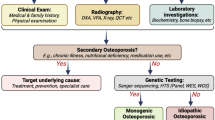Abstract:
The purpose of this study was to test the ability of early changes in markers of bone turnover to predict subsequent changes in bone mineral density (BMD) induced by parathyroid hormone fragment, PTH (1–34), in postmenopausal osteoporotic women treated with estrogen and glucocorticoids. Forty-nine postmenopausal women with chronic, inflammatory diseases and BMD T-scores ≤–2.5 at the lumbar spine or femoral neck who were concurrently treated with estrogen ≥ 1 year and prednisone 5–20 mg/day for ≥ 1 year participated. Subjects were randomized to treatment with human PTH (1–34) 400 IU/day or to a control group for 1 year and followed for an additional year. Serum and urine were collected at baseline and 1, 3, 6, 9, 12, 18 and 24 months for measurement of bone alkaline phosphatase (BAP), osteocalcin (OC) and deoxypyridinoline (DPD). We constructed an Uncoupling Index (UI) from all three markers (UI = [Z BAP+Z OC]/2 –Z DPD, where the Z-score for each marker in each subject was calculated from the mean and standard deviation of the study population at baseline). BMD of the lumbar spine and hip was measured at baseline and every 6 months thereafter by dual-energy X-ray absorptiometry (DXA) and annually by quantitative computed tomography (QCT; spine only). BMD of the spine, but not hip (total, femoral neck or trochanter), and levels of all three markers increased significantly as a result of PTH treatment (p<0.01 compared with controls). The resorption response lagged behind that of formation as evidenced by a significant increase (p<0.05) in the UI for the first 9 months of treatment. The UI values and changes from baseline to 1, 3 and 6 months in BAP, OC and DPD were correlated with the 12- and 24-month changes in spine BMD measured both with QCT and with DXA (Spearman’s rank coefficients ≤0.76; p<0.05). Most PTH-treated subjects could be identified as biochemical responders by least significant change analysis. Following 1 month of therapy, BAP and OC identified 65% and 81% as responders, respectively. The responder rates were 79%, 79% and 75% for BAP, OC and DPD, respectively by 6 months. Responders exhibited a high level of diagnostic accuracy for predicting a gain in BMD (areas under the receiver operating characteristic curves exceeding 0.79 for QCT and 0.70 for DXA), but not the magnitude of the gain. These data suggest that serial bone marker measurements may be useful in identifying skeletal responders to an anabolic therapy, such as PTH, in estrogen-replete postmenopausal women with glucocorticoid-induced osteoporosis.
Similar content being viewed by others
Author information
Authors and Affiliations
Additional information
Received: 27 July 1999 / Accepted: 2 November 1999
Rights and permissions
About this article
Cite this article
Lane, N., Sanchez, S., Genant, H. et al. Short-Term Increases in Bone Turnover Markers Predict Parathyroid Hormone-Induced Spinal Bone Mineral Density Gains in Postmenopausal Women with Glucocorticoid-Induced Osteoporosis . Osteoporos Int 11, 434–442 (2000). https://doi.org/10.1007/s001980070111
Issue Date:
DOI: https://doi.org/10.1007/s001980070111




